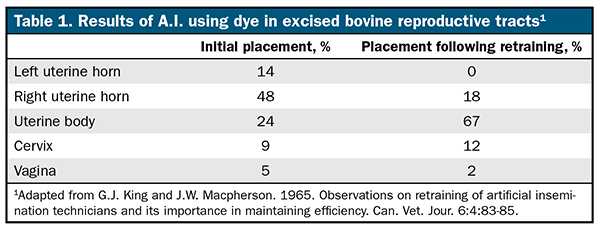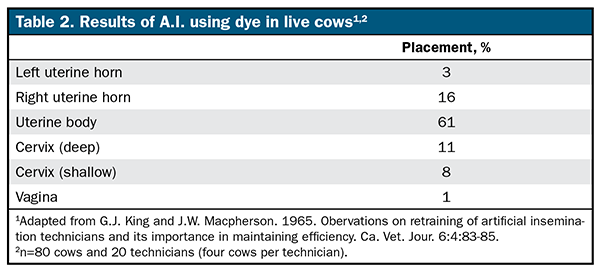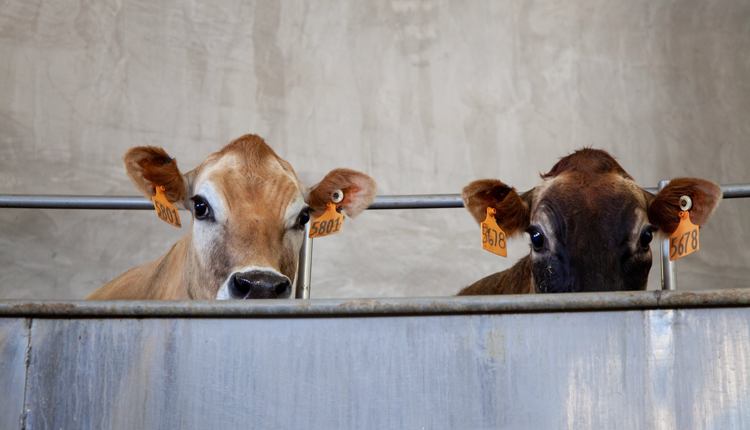The author is a professor and extension dairy specialist at the University of Idaho.

Location matters — in real estate, business, and A.I. During natural service, a mature bull deposits 8 to 10 billion sperm in the anterior vagina, near the cervix of the cow. One of the advantages of A.I. is the use of significantly fewer sperm, usually between 2 to 20 million, per service. However, with this sperm dose, deposition must occur in the uterus for acceptable fertility to be achieved.
Every few years, questions arise as to whether A.I. in the uterine horns results in greater fertility than deposition into the uterine body. The rationale is that the uterine horns are closer to the site of fertilization than the uterine body. Consequently, more sperm should be available for fertilization following A.I. in the uterine horns than if semen were deposited in the uterine body.
Perfect placement
In the 1980s, researchers at Penn State University reported that greater than 60% of sperm are lost from the reproductive tract by retrograde flow within 12 hours after A.I. Washington State University researchers found no difference in number of sperm lost (or conversely, retained) following A.I. in the uterine horns as compared to the uterine body. There was, however, a marked increase in number of sperm lost following A.I. in the cervix.
Many studies have compared A.I. in the uterine horns with deposition into the uterine body. Although some researchers reported improved fertility when conventional semen was deposited in the uterine horns rather than the uterine body, others found no difference in fertility.
Furthermore, an Irish study reported an effect from inseminator and deposition site with conventional semen with evidence of either rise, fall, or no effect of uterine horn deposition on fertility for individual inseminators. Studies with sexed semen report there is no evidence of greater fertility following deposition in the uterine horns compared to A.I. in the uterine body.
Using conventional semen, Brazilian researchers reported higher fertility following deep uterine horn A.I. on the same side as the ovary containing the dominant follicle compared to seminal deposition in the uterine body. In another study, Wisconsin researchers reported A.I. with conventional semen in the uterine horns failed to improve fertilization rates in superovulated Holstein cows.
Train and retrain
A possible explanation for the positive effect of uterine horn inseminations in a few of the aforementioned studies may be related to the elimination of cervical semen deposition. Cervical A.I. errors account for approximately 20% of attempted uterine body depositions, as reported by Penn State researchers. Canadian researchers reported a 10% decline in fertility to cervical A.I. when compared with deposition of semen in the uterine body.
Clearly, all A.I. personnel must develop sufficient skill to recognize when the tip of the A.I. gun remains in the cervix. To maximize fertility, A.I. technicians must continue to manipulate the reproductive tract until the tip of the A.I. gun is past the cervix and deposition into the uterus can be accomplished.
Retraining of A.I. technicians is important. Using excised reproductive tracts and A.I. guns with dye-filled straws, Canadian researchers reported approximately a 25% accuracy rate of technicians in placing the dye in the uterine body. After initial retraining, the accuracy of technicians improved to 67% (Table 1). Retraining with slaughterhouse tracts continued every three months until 80% to 85% accuracy of dye placement in the uterine body was achieved.

Next, the technicians inseminated live cows using A.I. guns containing dye plugs. Following slaughter, the reproductive tracts were recovered and dissected, with the placement results shown in Table 2. This provides evidence that further improvement of technicians in this program was possible. A strong relationship between technician accuracy with dye placement into the uterine body and subsequent fertility was also reported.

Following retraining, the greatest improvements in fertility were by two technicians with greater than 35,000 inseminations each. These technicians likely were performing A.I. in a state of procedural drift, defined as a mismatch between procedures and actual practice. One of the most likely reasons for the procedural drift was a gradual deviation from the routine, which then became routine. Retraining, however, allowed for identification of A.I. technique issues, correction of procedural drift, and increased fertility.
The uterine body is the accepted site of semen deposition in A.I. as there is no universal fertility benefit to further manipulation and deposition of semen into the uterine horns. For questions about A.I. training and retraining, contact your semen supplier or local university extension service. Happy A.I. breeding!










